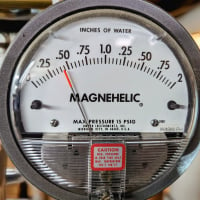Heat pump mini split question
Comments
-
I think 290 is propane.
But doesn't R-32 contain some 290 in the mix? I put an R-32 through the wall unit in my condo and I know it is 32 thinking I read that it is flammable??
0 -
difluoromethane is flammable:
0 -
-
-
I’d say at least 5 years maybe more. Not to say some old stock is not still there.
0 -
R-32 and R-454B (a blend of R-32 and R1234yf) are what you will see in the US taking the place of R-410A. These are both classified as an "A2L" refrigerant, neither contains any propane, both are considered flammable. I would suggest you seek out an A2L seminar, or take the A2L course from the EPA test site. The flammability of the refrigerant is definitely something to take seriously as an installer, however the charge of a through the wall unit is likely too low to even require sensors anywhere. If you were to look at the flame propagation of an A2L compared to R-410A it is actually very close, but propagates flame just outside of the cone at the testing facility that separates a "non-flammable" refrigerant (which are still flammable mind you) from a flammable refrigerant. The A2L classification was created because while it is flammable it is not flammable enough to warrant being in the class 2 or 3, so there was a need to more accurately classify this lower flammability refrigerant.
If you are comfortable with natural gas or propane gas lines running through your house, which can obviously leak a lot more fuel, and fuel that is much more flammable. Then I would think R-32 or R-454B would not cause you too much distress. Manufacturers have had to spend a mountain of cash developing sensors and mitigation systems for their split systems connected to gas furnaces.
2 -
Not to mention stoves that can be turned on without a flame and left.
Single pipe 392sqft system with an EG-40 rated for 325sqft and it's silent and balanced at all times.
0 -
I guess I was wrong but just remembered that R-32 was flammable when I installed the new through the wall unit which is R-32.
I am long past keeping up on that stuff.
I long for the days of 12, 22 and 502.
0 -
NO, They are not flammable!
They are mildly flammable.
Neither one will support combustion alone. Put a flame to them it burns, take the flame away and it goes out!0 -
That's strange
You might want to contact the manufacturers about their labeling then.
Single pipe 392sqft system with an EG-40 rated for 325sqft and it's silent and balanced at all times.
0 -
-
It literally says extremely flammable gas on it.
The UN classification is that it's flammable.
Here's R32
Here's Propane
Single pipe 392sqft system with an EG-40 rated for 325sqft and it's silent and balanced at all times.
0 -
-
Phosgene gas....that's what their big concern was back then. Mad Dog
0 -
R32 is definitely flammable. But it is much less of risk than propane by many metrics. It might have the same UN transportation classification as propane, but there is a reason that it has a different ASHRE classification.
Of course these classifications are based on real measurements, but the classification thresholds are somewhat subjective in nature. No one would deny that both gasoline and diesel are flammable, but the risks they present are different!
Here is a table comparing R32 to other refrigerants, including propane and butane. To get a flammable mixture you have to get about 7x the amount of R32 into the air, the minimum ignition energy is much higher, the flame speed is much lower, and the amount of energy released when it is burned is much lower:
(Table from )
2 -
You're spot on that R-290 is propane—it's a pure hydrocarbon refrigerant, and yes, it's highly flammable (A3 classification).
As for R-32 (difluoromethane), it's a different refrigerant altogether, but you're also right that it's flammable too, though not as much as R-290. R-32 is classified as A2L, which means:
- A = Low toxicity
- 2L = Mildly flammable
So yes, R-32 is flammable, just not to the same extreme level as R-290. That "2L" classification means it burns, but it's harder to ignite and burns slower than full-on A3 refrigerants like propane (R-290) or isobutane (R-600a). Both refrigerants are commonly used in modern cooling systems, including ductless mini split systems, due to their efficiency and lower environmental impact compared to older refrigerants like R-410A. When choosing ductless mini split systems, it’s worth noting that R-32 is often favored for its balance of efficiency and safety, while R-290 is less common in residential units due to its higher flammability. Always ensure proper installation and maintenance to mitigate any risks with these refrigerants.
2 -
Categories
- All Categories
- 87.3K THE MAIN WALL
- 3.2K A-C, Heat Pumps & Refrigeration
- 61 Biomass
- 427 Carbon Monoxide Awareness
- 119 Chimneys & Flues
- 2.1K Domestic Hot Water
- 5.8K Gas Heating
- 114 Geothermal
- 165 Indoor-Air Quality
- 3.7K Oil Heating
- 76 Pipe Deterioration
- 1K Plumbing
- 6.5K Radiant Heating
- 395 Solar
- 15.6K Strictly Steam
- 3.4K Thermostats and Controls
- 56 Water Quality
- 51 Industry Classes
- 50 Job Opportunities
- 18 Recall Announcements








